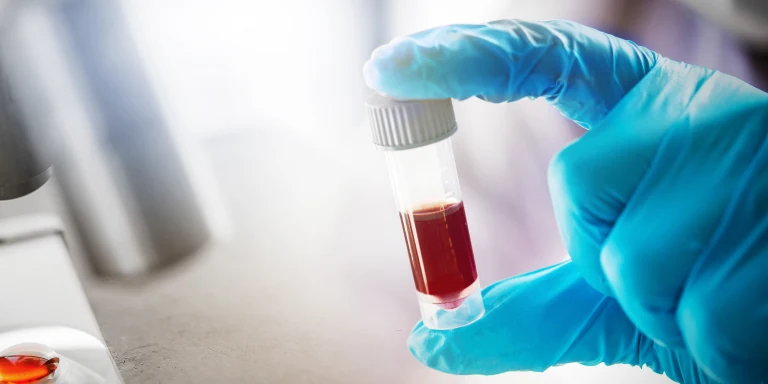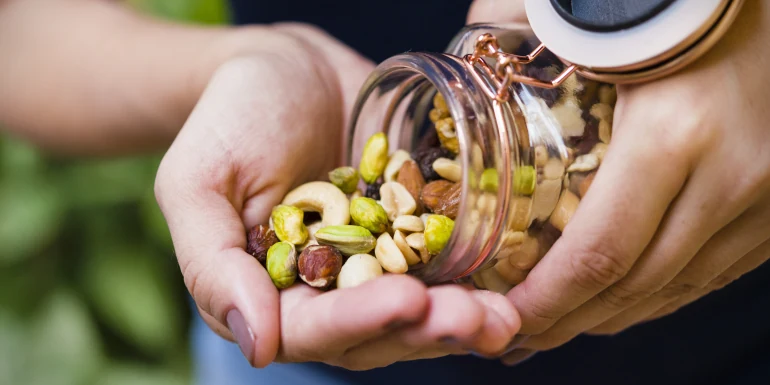
How are your iron levels?
Iron is vital for our bodies. It ensures an adequate supply of oxygen for our organs and cells and plays a key role in our immune response. How much iron should we absorb each day? And how do you measure iron levels?
The trace element iron is primarily responsible for transporting oxygen in the blood. It helps transport oxygen to the cells, where it’s converted into energy. Iron also ensures our muscles get the oxygen they need.
Iron deficiency and iron excess can both affect the way the body functions and impair its performance. Symptoms of iron deficiency include paleness, tiredness, lack of motivation, brittle nails and issues with the skin and mucous membranes. Iron is particularly important for children, growing teens, and during pregnancy.
How much iron do I need?
Our bodies can’t produce iron by themselves – we have to get it through food. Iron requirements depend on gender, age and other biological factors. Lifestyle also has an impact. Elite athletes, vegetarians and vegans need more iron.
- Women: 15 mg
- Men: 10 mg
- During pregnancy: 30 mg
- Breastfeeding: 20 mg
- Children: 8–10 mg
- Teenagers: girls 15 mg, boys 12 mg
The body actually needs “just” 1 to 4 milligrams of iron per day – yet only a fraction of the iron we consume in food can be absorbed by the intestinal cells and transported into the blood. The rest of the iron is lost. That’s why the recommended daily intake is significantly higher.
Menstruation means that normal iron requirements for women and post-pubescent girls are higher. During pregnancy and breastfeeding, they are even higher still, as mums help supply their babies with iron. After menopause, women’s iron requirements fall to 10 mg per day – the same as for men. If you have lost blood, for example during heavy periods, after giving blood or following surgery, your iron requirements will also be higher. It’s important to eat iron-rich foods at these times. 100 grams of oatmeal, for instance, contains 4.6 milligrams of iron.
Nutrition tips in Helsana Coach
The Helsana Coach app helps you achieve your personal health goals. The Coach programme “Healthy eating – step by step” has everything you need to know about how to maintain a balanced diet. Looking for recipe ideas? We’ve got those in the app, too.
Are my iron levels normal?
Age, gender and pregnancy are important factors to consider when looking at iron levels. A blood test will show whether your iron levels are too low or too high. If you suspect you might have an iron deficiency, your doctor will check the amount of iron in your blood. Several values – such as haemoglobin, ferritin and transferrin – are analysed in the blood to determine iron metabolism.
|
|
|
|
|---|---|---|
|
|
|
|
|
|
|
|
|
|
|
|
Minimum for women (not during pregnancy)
Minimum for men
Hb level (haemoglobin level)
12 g/dl
13 g/dl
Ferritin
15 ng/ml
15 ng/ml
Transferrin saturation
16 %
16 %
These are guideline values. Your doctor always interprets lab values on a holistic basis, taking into account your symptoms.
- The haemoglobin level shows how much iron is being supplied to the red blood cells. However, it only falls when iron stores are completely exhausted.
- Ferritin levels in your blood can tell you more about the iron in your body: iron is stored in the body by the protein ferritin. These levels fall as soon as iron stores are used up.
- Transferrin carries iron to all the body’s cells via the blood. Transferrin saturation indicates how much iron can be found in the transport protein transferrin. This is measured in the blood serum, like ferritin, the iron-storage protein.
- To ensure a reliable diagnosis, the doctor will often check your CRP level to rule out acute inflammation and infections. These can give a false picture of the actual ferritin and transferrin levels.
When iron levels are too low, this is known as iron deficiency. More rarely, people may also have excess iron, for instance if they suffer from iron overload, where the body accumulates too much iron. This can cause organ damage, particularly in the liver.
How can I test my iron levels?
If you’ve been suffering from fatigue or headaches for a long time, consult your doctor. Your iron levels may be too low. A blood test will help you find out quickly whether or not this is the case.
Important: Never take iron supplements as a precaution without a diagnosis. Unnecessary iron supply can damage your health.
At-home iron deficiency tests
Rapid tests are available in chemists and pharmacies. The testing kits are used at home and sent off for analysis. These iron-level tests measure the concentration of ferritin, where iron is stored. You take a few drops of your own blood and send the sample to a medical laboratory. Not everybody likes using these tests. While this type of iron-deficiency test is a modern innovation, it isn’t a reliable method of diagnosis. It serves as a starting point. Discuss your concerns about a potential iron deficiency with your doctor.

The expert in this field provided the editorial team with advice and input for this article. Eliane Wyss (medical assistant and nutrition coach) works in the Helsana health consultation service. She supports customers on questions to do with nutrition and other health topics.



Newsletter
Find out more about current health issues every month and get all the information you need about our attractive offers from all Helsana Group companies * delivered by e-mail to read whenever it suits you. Our newsletter is free of charge and you can sign up here:
We did not receive your information. Please try again later.
* The Helsana Group comprises Helsana Insurance Company Ltd, Helsana Supplementary Insurances Ltd and Helsana Accidents Ltd.
